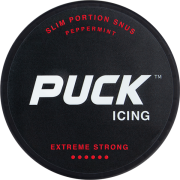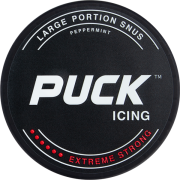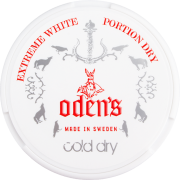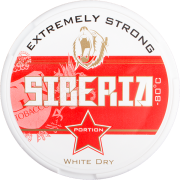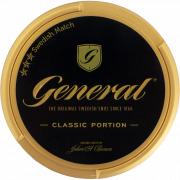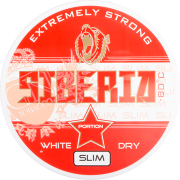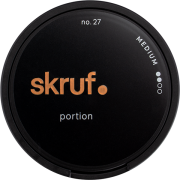Attention: Snus is not available to all destinations. You will be notified of restricted products in the checkout.
Snus
Snus, Swedish Snus, is a smokeless tobacco product that comes in many different formats, flavors, and strengths. This includes preportioned snus, or snus pouches, either in original or white format, boasting a range of tobacco-centric, mint, and fruit flavor profiles. Pick from low-strength to strong snus, tailoring the experience to best suit your preferences. At SnusExpress, a wide selection of snus is available and is stored in optimal conditions, keeping products as fresh as when they left the factory. Buy snus from SnusExpress and benefit from the many advantages it brings.
What is Snus?
Snus is a traditional tobacco product that originated from Sweden in the 1800s. It is placed between the upper lip and gum for up to an hour whereby saliva extracts the nicotine and flavor, then absorbed across the oral membrane. Traditionally, it comes loose, and users ‘pinch’ and form their own ‘prilla’ and place it against their gum. More recently, snus pouches or preportioned snus has become available, removing the need to pinch the tobacco, and simplifying the technique.
Swedish snus contains pasteurized tobacco and many different flavorings, varying from peppermint to juniper, and citrus. Also, strengths and pouch sizes vary facilitating those with different nicotine tolerances and allowing users to sculpt their own snus experience. There’s a product for all preferences.
Snus Tobacco: What are the Ingredients in Snus?
Many types of tobacco or Nicotiana originate from different parts of the world including the Americas, Africa, and Australia, each having a unique taste and aroma. Different brands create unique blends with multiple tobacco plants, creating an individual tasting profile separating each snus brand. Other than tobacco, different flavorings amongst other less obvious substances are used, explored below:
- Ground Tobacco
- Flavor Enhancers/Salt
- Water
- Sodium Carbonate
- Flavorings
- Moisture preserving agents
Most substances listed above and their use reasons are straightforward apart from sodium carbonate. Sodium carbonate is used to adjust the pH, which affects the ability and extraction of nicotine from the tobacco plant.
Types of Snus: What are They?
The type of snus, as well as its strength and flavor, can vary. This can involve the product's moisture, format, and the way the tobacco has been prepared. All of these can affect the experience through the feel under the lip and the speed and intensity of the nicotine and flavor release. Below, the different types are bullet-pointed.
- Loose Snus is ground tobacco, fine or coarse, that’s moist and requires the user to form their own ‘prilla’.
- Original Portioned Snus is similar to loose Snus as the tobacco is moist and has the same dark color but it’s preportioned into sachets.
- White Snus is much dryer. In turn, it lasts much longer, is less intense, and produces less drip.
- All White Portions are very different in the way the tobacco is prepared. The tobacco is bleached and dry, making the snus pouch white, removing the chance of getting stained teeth after use.
What are the Different Snus Pouches?
Another factor that influences the experience is the size of the snus pouches. The weight of the different sizes can range from around 0.5 to 1 gram per portion, influencing product strength and mouthfeel. Below, the different sizes are uncovered, detailing how their characteristics influence the snus experience.
- Mini - Short and narrow sachets weighing around 0.5 grams each, sitting easily under the lip while providing a comfortable experience.
- Slim - These narrow and long pouches weigh from 0.7 to 0.8 grams each. Each snus will sit snug under the upper lip, with little to no movement.
- Regular - The most popular snus pouch and the first portion to be invented. Each weighs around 1 gram, providing plenty of tobacco, a full lip feel, and an immersive experience.
- Large - This size isn’t very common and few products come in this format. But those that do, weigh more than 1 gram and are best suited to experienced users.
How to Use Snus
As touched on throughout, snus is easy and discreet to use. All there is to do is pick a pouch and place it against your gum, underneath your top lip. It is possible to place it underneath your bottom lip but excess drip may be produced, reducing the enjoyment of the experience. The longevity of the snus experience changes, varying from 45 minutes to over an hour. Once finished, place the used product in the catch lid of your can and carry on with your day.
Snus Near Me - Where to Buy Snus?
When you go to buy snus, users want the most convenient and seamless shopping experience possible. Some look online, where the closest store that sells snus is while others take it an extra step and order from an E-store like SnusExperess. Buying snus from the local convenience store or gas station has many benefits and is something users have done for years. However, buying online comes with many more benefits, that are discussed further.
Buy Snus Online at SnusExpress
Buying snus online comes with many benefits, some of which include:
- Convenience
- Discretion
- Wide variety of snus
- Competitive prices
- Speedy delivery
- Product Expertise
- Correct storage, retaining freshness
The Top 3 Best Snus
Many aren’t sure which snus to buy because of the vast selection available at SnusExpress. For those that aren’t as familiar with the market then the best-selling snus is a fantastic place to start. Below are the top 3 snus users add to their SnusExpress basket each time they buy fresh products.
All the products mentioned above are quite modern, in terms of format, white and slim pouches, showing the evolving preferences of the snuser. However, classic products like Ettan Loose are still just as popular as they once were.
Which are the Best Snus Brands?
When it comes to snus brands, each has its niche and specific tobacco character, meaning users will prefer different brands. Some have stood the test of time and remain popular after years of competition, while others have burst onto the scene with something new and revitalizing. Below, are some brands that occupy most snusers’ rotations.
- General Snus
- Siberia Snus
- XR Snus
- Knox
Although these are some of the more favored brands do not let it put you off other snus brands. There are many, and all those stocked on SnusExpress are of the best quality.
Most Common Snus Flavors
As well as formats, strengths, and brands, there are different flavor categories of snus, consisting of subtle tobacco character differences and herbal and fruity additions. Some tasting profiles are more popular than others and this is noticeable by looking at which tastes are within each brand's line. Some of the more common and favored flavor profiles include:
- Classic - centers around the natural tobacco flavorings with subtle additions of herbs and spices like bergamot and juniper.
- Mint - brands still use the characters supplied in their tobacco blends but compliment them with endearing notes of mint, whether peppermint, spearmint, menthol, or a mixture of all.
- Fruit - sometimes users want a sweet taste and get that through a fruity addition to their snus. Some of the more popular flavors across brands include berries and melon.
There are other more intriguing flavors available, like tastes that are beverage-inspired and utilize flavors such as whiskey or cola. Other, more adventurous options are available for all kinds of preferences.
Strong Snus: Which is the Strongest?
The strength of snus can vary massively. Some lower-strength snus can contain as little as 4mg of nicotine per portion. On the other hand, strong snus can contain as much as 43 mg/g of nicotine. So the nicotine strength spectrum is very wide. Some brands are known for their high-strength snus, like Siberia and Odens Snus, while others provide a more regular range for the standard snuser.
In terms of the strongest snus pouch, a few products come to mind, including:
It is important to note that using extremely strong snus is not recommended, especially for those new to tobacco and nicotine, and is only suitable for veteran snusers. Moreover, the experience provided by regular strength snus is far more enjoyable and still delivers a satisfying sensation.
1x 10x 30x 50x
1x 10x 30x 50x


